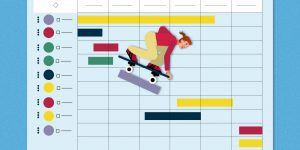The precedence diagramming method of project activities is a visual representation technique that shows the interdependencies of activities and is used in the development of project planning.
CONTENT
With so many challenging responsibilities involved in managing a project, project management has become even more demanding, so using assistive tools is becoming increasingly valuable.
The precedence diagramming method is a great communication tool for stakeholders.
Let’s have a look at it in more detail in this article.
What is the Precedence Diagramming Method (PDM)?
The Precedence Diagramming Method, is a visual strategy for project planning network diagram development that makes use of rectangles, also called nodes, to symbolize activities. Because of this, it is also called Activity on Node (AON).
This method visually represents any pre-existing, recognized planning activity through the use of interconnected nodes.
The major benefit of using the precedence diagram method is that it quickly allows the project team to understand all scheduled and affiliated activities.
Using the precedence diagramming method, you can:
- Visually display the project progression as a precedence diagram
- Determine if you are on schedule
- Quickly identify dependencies among activities and the effect of any modifications
- Pinpoint critical processes and activities and report them as a critical course.
A precedence diagram can represent a whole project, but you can also create a partial diagram that shows only a portion of a project.
Indeed, not all stakeholders, are interested in having the overall, detailed presentation.
How to build a precedence diagramming method (PDM)
To build a PDM method of precedence diagramming, the preliminary stage of planning is to focus on the work breakdown structure.
The overall project becomes more convenient and manageable when breaking the tasks down into smaller assignments.
Below are some steps for creating a precedence diagram:
- Make sure you have a blank page or a blackboard to draw the plan on
- Insert the final result of the work breakdown structure on the right side of the page
- Report each activity from the breakdown structure and arrange them in the order in which they are to happen.
- Work from the left until you have dependencies between tasks and get a function sequence going from left to right.
- Make sure there is no standalone activity with no connection.
As the project advances, there may be more tasks that need to be done; these can be included in the diagram and work breakdown structure.
Relationship types in precedence diagramming method
With the precedence diagramming method, four types of relationships are used in activities. These are:
- Finish-Start (FS): is the most common relationship type used between activities. An activity cannot begin until the previous one is completed. For example, to paint a wall you must first build it, so the first activity is building the wall, and the second one is painting it.
- Start-Finish (SF): is the lesser used relationship in a precedence diagramming method. In this case, the B activity may end only after the A activity begins. For example, your old house will be demolished to build a new one. In this case, you cannot move into your new house until it is ready. Therefore, the second activity (building the new house) must be completed before the first activity (moving into a new house) begins.
- Start-Start (SS): is a type of relationship that shows that the next activity cannot be started until the first one begins. Both activities should therefore begin at the same time. For example, you need to apply a coating to a wall, but the wall needs to be cleaned first. Therefore, one team will clean the wall, while the other team will coat it. Both activities can begin at the same time.
- Finish-Finish (FF): In this case, the following activity cannot be completed until the first one is concluded. For example, in an IT project, during testing, bugs will be found related to the software being developed. These bugs will be fixed by the developers, and then the testing team will have to double-check that the bug is actually fixed. Therefore, testing and bug fixing activities are an example of this type of relationship.
Dependency types in precedence diagramming method
Four types of dependencies are used to define activity sequences:
- Mandatory Dependency: This dependency is also known as “hard logic” and you cannot avoid it because the beginning of the next activity depends on this type of connection. For instance, you can’t build a ceiling until you have built all the walls of a house.
- Discretionary Dependency: this dependency is also known as “soft logic” and is involved in resource optimization. For instance, you can build all four walls of a house in any sequence. However, if building them in a certain order is beneficial, then they will be built in that exact order. Discretionary dependencies are supervised by the project team and can be modified to shorten the project. In this technique, the tasks remain the same, but the order changes.
- External Dependency: These come, of course, externally to the project and the team has no control over them. For example, you may need government approval before you begin your next project activity.
- Internal Dependency: these are under the project or organization’s control. For example, a resource cannot be obtained until it is released from another project.
Benefits of the precedence diagramming method
The use of the precedence diagramming method brings a number of benefits to project management, including:
- It helps in finding relationships and dependencies between activities. This , in turn, helps in planning and avoiding risks.
- It helps to find critical activities and focus on them. Any delay in critical activities will set back the entire program.
- It is a fine communication tool, as project stakeholders can see the activities and get an understanding of the program.
- Without a precedence diagram, project planning cannot be developed.
Start now with our help
The amount of effort involved in creating a precedence diagram is relatively high, mainly because prior knowledge of work packages and the critical path is required, but with a project management software is so much easier.
Twproject can help you designing your WBS and your precedence diagram in few steps with important benefits.
The predictive power of the precedence diagram depends on the quality of the estimates of effort and task duration, and all this can be learned in time thanks to a software that can keep all your project history for future analysis.
Create your precedence diagram, assign your team to correct phases with correct estimation, keep track of everything is happening and helps your team with prioritized to do lists. Track your project history and learn for your experience!





